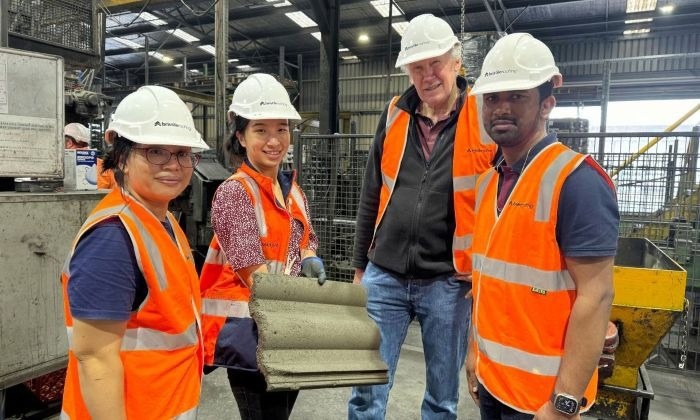A comprehensive trial of eco-friendly roof tiles conducted by RMIT in collaboration with Bristile Roofing has demonstrated that including coal ash and glass waste can significantly lower carbon emissions.
 RMIT's Dr. Yulin Patrisia, Bristile Roofing's Samantha So, RMIT's Dr. David Law and student Madushan Mudiyanselage at the Bristile factory in Dandenong. Image Credit: RMIT
RMIT's Dr. Yulin Patrisia, Bristile Roofing's Samantha So, RMIT's Dr. David Law and student Madushan Mudiyanselage at the Bristile factory in Dandenong. Image Credit: RMIT
The study was published in Sustainable Materials and Technologies, the environmental evaluation was published in The International Journal of Life Cycle Assessment, and the engineering performance results were published in Case Studies in Construction Materials.
The extensive manufacturing trials at Bristile Roofing’s facility in Melbourne resulted in numerous concrete tiles that incorporated ash waste from coal-fired power plants and glass – two difficult waste materials – providing ecological and engineering advantages.
The end product was lighter and exhibited enhanced fire resistance while conforming to Australian Standards for strength and durability.
A thorough circular life cycle assessment of the new tiles, encompassing the complete process from raw materials to end-of-life landfilling, revealed a 13 % decrease in CO2 emissions compared to traditional concrete tiles.
Dr. Chamila Gunasekara, the project lead at RMIT, stated that this significant environmental advantage primarily arises from using harvested pond ash and unwashed recycled glass sand, which eliminates energy-intensive processing and is an effective substitute for virgin materials.
By replacing 10 % of cement with harvested pond ash and 10 % of river sand with unwashed glass waste – a total of 20 % virgin material replacement – we not only reduce waste going to landfill but also produce an improved concrete product with enhanced fire resistance, a valuable feature for roofing in Australia’s climate.
Dr. Chamila Gunasekara, Project Lead, RMIT
In Australia, around 12 million tons of coal ash are generated each year from electricity production, with over 400 million tons currently held in extensive settling ponds.
Similarly, more than 1.3 million tons of glass waste are produced annually, of which more than 50 % is still disposed of in landfills.
Dr. Yulin Patrisia, Principal Research Fellow at RMIT, stated that the trial demonstrated the ability to incorporate substantial amounts of this industrial waste without sacrificing quality and safety.
While harvested waste pond ash is less reactive – primarily due to prolonged storage in settling ponds – it remains an attractive material due to its abundance and contribution to long-term engineering performance. Despite its lower early reactivity, it helps enhance concrete performance over time. Our tests showed better dimensional stability, reduced shrinkage cracking, and continued strength gain – making it ideal for durable, non-structural applications.
Dr. Yulin Patrisia, Principal Research Fellow, RMIT
Additional partnerships with local councils and commercial entities are being developed to test the roof tiles in practical environments.
“This is more than just a lab success. We are ready to scale this for industry,” said Gunasekara.
It is necessary to scale up by identifying dependable local waste resources that maintain consistency in quality, availability, and adequate volume.
Building Out Impact From Roof Tiles to Bricks
The design of the concrete mix extends its applications beyond merely roof tiles.
One of the prototypes developed by the team consists of concrete bricks that incorporate 15 % harvested pond ash and 20 % unwashed glass sand, amounting to a total of 35 % waste materials. This composition meets Australian standards for load-bearing structural concrete and fire performance in wall elements.
The analysis revealed that the inclusion of these waste materials enhances insulation, leading to a 30 % reduction in heat loss when compared to traditional cement bricks.
Meanwhile, the comprehensive life cycle assessment, which encompasses processes from the production of raw materials to the landfilling at the end of life, demonstrated an 18 % reduction in CO2 emissions achieved through material substitution and the avoidance of impacts.
The team is advancing toward manufacturing trials for the concrete brick product in partnership with an industry collaborator.
The current research is being backed by the ARC Industrial Transformation Research Hub, which focuses on the Transformation of Reclaimed Waste Resources into Engineered Materials and Solutions for a Circular Economy (TREMS).
Under the guidance of Professor Sujeeva Setunge from RMIT, TREMS brings together prominent scientists and industry experts from nine Australian universities, along with 36 collaborators from government, industry, and international sectors, to reduce waste and convert reclaimed materials into high-value products for construction and advanced manufacturing.
The study is additionally backed by Sustainability Victoria's Circular Economy Markets Fund, which promotes innovation in sustainable construction and the utilization of circular resources.
Journal References:
Patrisia, Y., et al. (2025) Advanced manufacturing of waste-integrated concrete roof tiles: Scaling up to TRL 6. Sustainable Materials and Technologies. doi.org/10.1016/j.susmat.2025.e01461.
Patrisia, Y., et al. (2025) Assessment of waste-integrated concrete products: a cradle-to-cradle perspective. The International Journal of Life Cycle Assessment. doi.org/10.1007/s11367-025-02443-w.
Patrisia, Y., et al. (2025) Optimizing engineering potential in sustainable structural concrete brick utilizing pond ash and unwashed recycled glass sand integration. Case Studies in Construction Materials. doi.org/10.1016/j.cscm.2024.e03816.